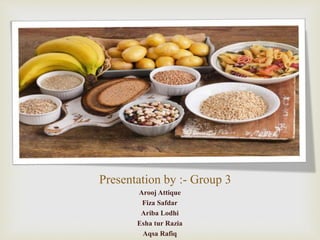
Presentation
- 1. Presentation by :- Group 3 Arooj Attique Fiza Safdar Ariba Lodhi Esha tur Razia Aqsa Rafiq
- 2. It is present into vegetable cells and contains two types of homopolysaccharides, amylose and amylopectin. Structure & composition of starch:-
- 3. It is an unbranched homopolysaccharide formed by about 5-600 glucose units, linked by a-(1- 4) glycosidic bonds. It has a helix structure with six glucose units for turn, is soluble in water and places in the core of the starch granules. Amylose
- 4. It represents about 80% of polysaccharides taken up with diet. It is branched molecule formed by thousands of glucose units, up to 50000, that in main chain, are joined by a-(1- 4) glycosidic bonds, Approximately every 25-30 glucose units a branch point or lateral chain is present, formed by glucose units as well, joined to the main chain by a-(1-6) glycosidic bonds, glucose units on the lateral chain, from 16 to 25, are linked again by a-(1- 4) glycosidic bonds. The branches prevents the formation of a helical structure while allow the creation of spongy reticular structures. Amylopectin:-
- 5. Caramelization:- When exposed to heat, sugar will at first melt into a thick syrup. As the temperature continues to rise, the sugar syrup changes color, from clear to light yellow to a progressively deepening brown. This browning process is called caramelization. It is a complicated chemical reaction, and in addition to color change, it also causes the flavor of the sugar to evolve and take on the rich complexity that we know to be characteristic of caramel. Different types of sugar caramelize at different temperatures. Granulated white sugar melts at 320°F/160°C and begins to caramelize at 338°F/170°C. Starch reactions on foods:
- 6. Maillard reaction:- In foods that are not primarily sugar or starch, a different reaction, known as the Maillard reaction, is responsible for browning. This reaction involves sugars and amino acids (the building blocks of protein). When heated, these components react and produce numerous chemical by-products, resulting in a brown color and intense flavor and aroma. It is this reaction that gives coffee, chocolate, baked goods, dark beer, and roasted meats and nuts much of their rich flavor and color.
- 7. Starch, a complex carbohydrate, has powerful thickening properties. When starch is combined with water or another liquid and heated, individual starch granules absorb the liquid and swell. This process, known as gelatinization, is what causes the liquid to thicken. Gelatinization occurs at different temperatures for different types of starch. As a general rule of thumb, root-based starches (potato and arrowroot, for instance) thicken at lower temperatures but break down more quickly, whereas cereal-based starches (corn and wheat, for example) thicken at higher temperatures but break down more slowly. High levels of sugar or acid can inhibit gelatinization, while the presence of salt can promote it. Gelation:- The process of forming a gel that occurs after the gelatinization process and during cooling is called Gelation. Example:- The cooling of Jell-O after preparation of the Gelatinization:-
- 8. The breakdown of starch molecules to smaller, sweetier tasting molecules (dextrin) by enzymes, acid or dry heat. Dextrin are partially hydrolyzed starches that are prepared by dry roasting starch. In home kitchens, dextrinization is achieved by toasting of flour for polvoron, rice flour for kare-kare sauce and bread slices for breakfast. Dextrinization:-
- 9. When cooled, gelatinize amylase containing starches set into a rigid gel. Retrogradation is a reaction that takes place when the amylose and amylopectin chains in cooked, gelatinized starch realign themselves as the cooked starch cools. When native starch is heated and dissolves in water, the crystalline structure of amylose and amylopectin molecules is lost and they hydrate to form a viscous solution. If the viscous solution is cooled or left at lower temperature for a long enough period, the linear molecules, amylose, and linear parts of amylopectin molecules retrograde and rearrange themselves again to a more crystalline structure. The linear chains place themselves parallel and form hydrogen bridges. In viscous solutions the viscosity increases to form a gel. At temperatures between –8 and +8 °C the aging process is enhanced drastically. Retrogradation can expel water from the polymer network. This is a process known as syneresis. A small amount of water can be seen on top of the gel. • Retrogradation:-
- 10. Retrogradation can expel water from the polymer network. This is a process known as syneresis. A small amount of water can be seen on top of the gel. Retrogradation is directly related to the staling or aging of bread. Retrograded starch is less digestible. Chemical modification of starches can reduce or enhance the retrogradation. Waxy, high amylopectin, starches also have a much lesser tendency to retrogradate. Additives such as fat, glucose, sodium nitrate and emulsifier can reduce retrogradation of starch. Retrogradation:-
- 11. It is characterized by the expulsion of moisture from the gel. This reaction occurs in all kinds of gels: Puddings Jellies Custards Gelatin Agar Syneresis:-